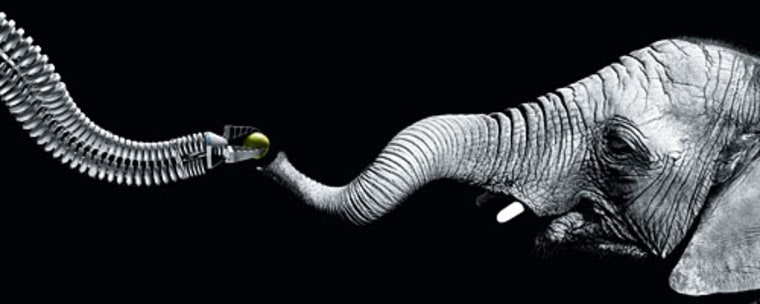Though it looks more like Dr. Octopus' mechanical tentacles from "Spiderman," a flexible, robotic arm recently developed by German automation company Festo was actually fashioned after an elephant's trunk.
The arm, dubbed the Bionic Handling Assistant, could safely operate around people in tight quarters in homes, schools and medical rehabilitation centers, according to its inventors.
Elephants variously use their trunks — which are actually an extended fusion of their noses and upper lips — as a strong yet bendable appendage to grab food, fight and even greet each other with "trunk shakes."
In designing the Bionic Handling Assistant, Festo took a page from nature's playbook rather than go with the metal skeletal bars and tubes that comprise conventional robotic arms. "Biomimicry," as this design and engineering aesthetic is called, draws inspiration from the biomechanical systems that the process of evolution has honed for millions of years, often resulting in startling insights over manmade artificial solutions. [Read: Future Planes Could Land Upright Like Birds and New Robot Climbs Walls Like an Ape Going Up a Tree ]
Instead of the 40,000 or so muscles that allow pachyderms to precisely manipulate their trunks, Festo's trunk relies on the sequential inflation of tiny air bladders to determine movement and compliance.
The bladders line the interior of the Bionic Handling Assistant somewhat like inflatable vertebrae, running the length of the arm as two rows. The bladders are divided into three sections to allow for S-curve-like dexterity; by puffing up a row on one side of the trunk, for example, the trunk will bend in the opposite direction.
A so-called hand axis acts as a final fourth section just prior to Festo's three-pronged FinGripper, which itself is based on the architecture of fish tail fins. The FinGripper caps off the trunk and provides for delicate grasping abilities.
Sensors embedded in the arm allow for fine motor control and also act as collision detectors that stop the arm in its tracks should it bump into an object such as, well, a person.
The mecha-trunk is made of a polyamide, which is a durable, flexible category of materials that includes nylon, silk and Kevlar.
• Freaky! Fembot Sings, Mimicking Pop Stars
• Knife-Wielding Robots Could Soon Invade the Kitchen
• 5 Reasons to Fear Robots
